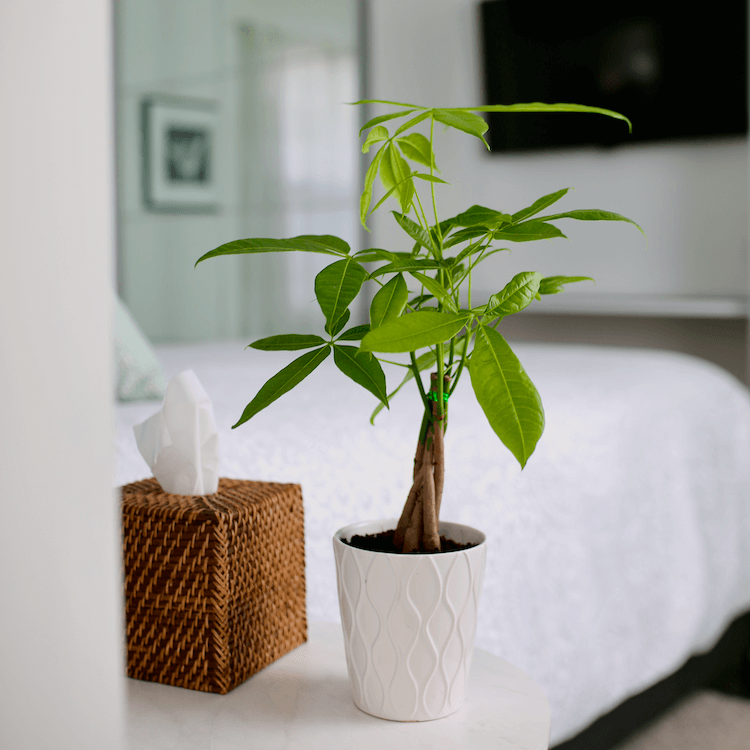
The Money Tree, scientifically known as Pachira aquatica, is adored for its lush green leaves and unique braided trunk. This charming houseplant is not just a decorative piece but also a symbol of prosperity and good fortune.
It's like that easygoing friend who goes with the flow and rarely complains, which is one of the many reasons it makes a great houseplant. But there is one thing it doesn’t like: too much water.
You brought home your plant, and you became a bit of a helicopter parent, eager to keep your plant healthy and you overwatered it, causing damage to the roots and leaves. We know it can be challenging to trust that a plant is easy-going and doesn’t need much work, but we mean it with money trees. They can tolerate a lot, and with the proper balance of care, they won’t ask for much from you.
We know that overwatering can be an easy mistake to make, but thankfully, it is even easier to fix.
Here’s what you need to know about watering your money tree plant.
Proper Money Tree plant care is crucial for its growth and prosperity. Unlike orchids and most other indoor plants, your money tree plant only needs about 6-8 ounces of water every three weeks, according to our growing experts.
Watering weekly is a lot easier to remember, so we recommend giving it two ice cubes (or 3 tablespoons of water) every week. Pick whichever watering method is easiest for you to remember.
If you miss a week, you can double up, but don’t go overboard. If your plant gets too much water, its root system and leaves will stretch out, which can result in brown leaves.
Make sure your money tree plant has a good drainage system, too. This will prevent the roots from rotting. Our grower pots are designed with a built-in elevated bottom so that the roots are not sitting in water. We advise that every few waterings, you remove the grower pot from the decorative pot to make sure your money tree plant isn’t just sitting in any water.
Whether you're a seasoned plant enthusiast or a beginner eager to learn how to care for a Money Tree, understanding proper Money Tree maintenance is key to its health and longevity. Money trees are great for college dorm rooms, apartments, and anywhere else that needs a touch of nature.
Avoid too much direct sunlight, which can burn its leaves. Place it near a south-facing window during the summer months and move it to your east window in the winter. You’ll notice that it is getting too much sun if the leaves begin to brown on the edges.
Prune browning leaves throughout the year to encourage new growth. You can trim them off with sterile scissors or gently remove them by hand.
Repot your money tree plant every year or two in a pot that’s just slightly larger. This will encourage it to keep growing and give the roots room to expand safely.
For optimal Money Tree growth, selecting the right fertilizer and applying it correctly is crucial. A balanced liquid fertilizer, such as a 20-20-20 NPK formula, diluted to half strength, is recommended. Apply every four to six weeks during the growing season from spring to early autumn, ensuring your plant receives necessary nutrients.
Look for signs indicating your Money Tree needs fertilization, like pale or yellow leaves and stunted growth. If older leaves drop or the plant appears unhealthy, a nutrient boost may be needed.
To encourage healthy growth, periodically rotate your Money Tree for even light exposure, promoting balanced growth. Prune leggy or overgrown branches to encourage bushier growth. Ensure your plant is in well-drained soil and a suitable pot for root expansion. Combined with regular fertilization, these practices will help you cultivate a thriving, beautifully shaped Money Tree.
The Money Tree originates from the wetlands of Central and South America and has a rich cultural significance. It's widely known as a symbol of luck and financial success, making it a popular choice for homes and offices worldwide. With its glossy leaves, this houseplant enhances any space's aesthetic and purifies the air.
In many cultures, particularly in Feng Shui, the Money Tree is revered for attracting wealth and prosperity. It's a popular gift for new ventures or housewarming events, often with rituals like placing coins in its pot or positioning it in the southeast corner of a room to enhance its beneficial properties. With its deep-rooted symbolism and aesthetic charm, the Money Tree remains a timeless choice for those seeking beauty and blessings in their environment.
Choosing the right soil and potting practices is crucial for Money Tree maintenance. A well-draining potting mix, such as a blend of potting soil, peat moss, and perlite, is ideal. Select a pot with drainage holes to allow proper water flow. Repotting every couple of years refreshes the soil and provides room for root growth.
Learning how to care for a money tree plant can be rewarding, but it also poses challenges. Money tree watering issues are common, with yellowing or dropping leaves indicating overwatering, and wilting or crispy leaves suggesting underwatering. Ensure your pot has good drainage and let the soil dry between waterings. If underwatering is the issue, increase the watering frequency, keeping the soil moist but not soggy.
Pest infestations, such as spider mites, mealybugs, and aphids, can affect your Money Tree houseplant. Regularly inspect your plant and wipe leaves with a damp cloth to remove pests. If necessary, use insecticidal soap or neem oil according to instructions for effective pest control.
Yellowing money tree leaves or stunted growth may signal nutrient deficiencies or inadequate lighting. Ensure your plant receives bright, indirect sunlight, as excessive direct sunlight can damage the leaves. For nutrient deficiencies, use a balanced fertilizer every few months during the growing season to promote healthy growth and vibrant foliage.

Copyright Just Add Ice® Orchids 2023